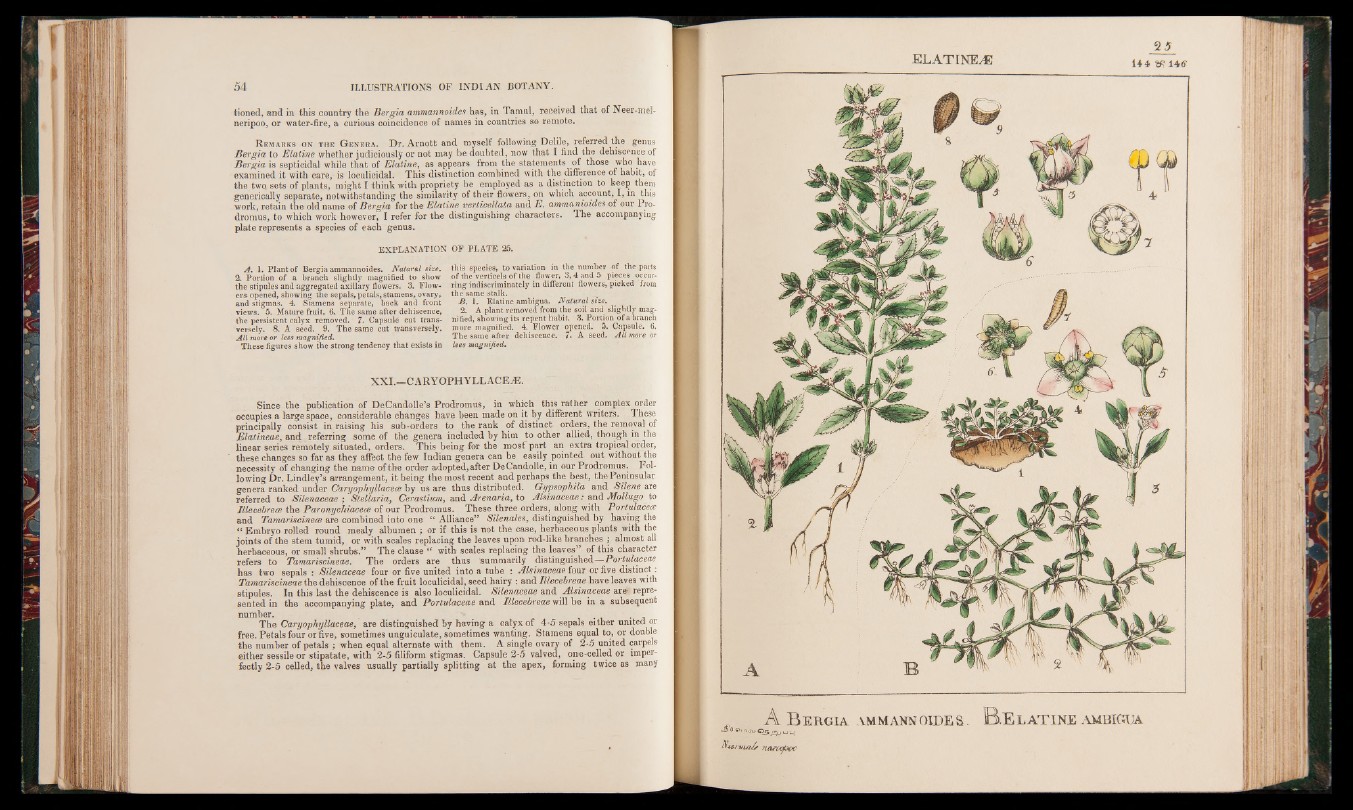
tioned, and in this country the Bergia ammannoides has, in Tamul, received that of Neer-mel-
neripoo, or water-fire, a curious coincidence of names in countries so remote.
R emarks on the G enera. Dr. Arnott and myself following Delile, referred the genus
Bergia to Elatine whether judiciously or not may be doubted, now that I find the dehiscence of
Bergia is septicidal while that of Elatine, as appears from the statements of those who have
examined it with care, is loculicidal. This distinction combined with the difference of habit, of
the two sets of plants, might I think with propriety be employed as a distinction to keep them
generically separate, notwithstanding the similarity of their flowers, on which account, I, in this
work, retain the old name of Bergia for the Elatine verticellata and E. ammanioides of our Pro-
dromus, to which work however, I refer for the distinguishing characters. The accompanying
plate represents a species of each genus.
EXPLANATION OP PLATE 25.
A . 1. Plant of Bergia ammannoides. Natural size.
2. Portion of a branch slightly magnified to show
the stipules and aggregated axillary flowers. 3. Flowers
opened, showing the sepals, petals, stamens, ovary,
and stigmas. 4. Stamens separate, back and front
views. 5. Mature fruit. 6. The same after dehiscence,
the persistent calyx removed. 7. Capsule cut transversely.
8. A seed. 9. The same cut transversely.
A ll more or less magnified.
These figures show the strong tendency that exists in
this species, to variation in the number of the parts
of the verticels of the flower, 3 ,4 and 5 pieces occurring
indiscriminately in different flowers, picked 'from
the same stalk.
B . i . Elatine ambigua. Natural size.
2. A plant removed from the soil and slightly mag-
nified, showing its repent habit. 3. Portion of a branch
more magnified. 4. Flower opened. 5. Capsule. 6.
The same after dehiscence. 7. A seed. A ll more or
lees magnified.
XXI.—CARYOPHYLLACEA3.
Since the publication of DeCandolle’s Prodromus, in which this rather complex order
occupies a large space, considerable changes have been made on it by different writers. These
principally consist in raising his sub-orders to the rank of distinct orders, the removal of
Elatineae, and referring some of the genera included by him to other allied, though in the
linear series remotely situated, orders. This being for the most part an extra tropical order,
these changes so far as they affect the few Indian genera can be easily pointed out without the
necessity of changing the name of the order adopted, after DeCandolle, in our Prodromus. Following
Dr. Lindley’s arrangement, it being the most recent and perhaps the best, the Peninsular
genera ranked under Caryophyllacece by us are thus distributed. Gypsophila and Silene are
referred to Silenaceae ; Stellaria, Cerastiwn, and Arenaria, to Alsinaceae : and Mollugo to
Illecebrece the Paronyclnacece of our Prodromus. These three orders, along with Portulacece-
and Tamariscinece are combined into one “ Alliance” Silenales. distinguished by having the
“ Embryo rolled round mealy albumen ; or if this is not the case, herbaceous plants with the
joints of the stem tumid, or with scales replacing the leaves upon rod-like branches ; almost all
herbaceous, or small shrubs.” The clause “ with scales replacing the leaves” of this character
refers to Tamariscineae. The orders are thus ’summarily distinguished—P'ortulaceae
has two sepals : Silenaceae four or five united into a tube : Alsinaceae four or five distinct:
Tamariscineae the dehiscence of the fruit loculicidal, seed hairy : and Illecebreae have leaves with
stipules. In this last the dehiscence is also loculicidal. Silenaceae and Alsinaceae are represented
in the accompanying plate, and Portulaceae and Illecebreae will be in a subsequent
number. . "•* . .
The Caryophyllaceae, are distinguished by having a calyx of 4-5 sepals either united or
free. Petals four or five, sometimes unguiculate, sometimes wanting. Stamens equal to, or double
the number of petals ; when equal alternate with them. A single ovary of 2-5 united carpels
either sessile or stipatate, with 2-5 filiform stigmas. Capsule 2-5 valved, one-celled or imperfectly
2-5 celled* the valves usually partially splitting at the apex, forming twice as many
ELATINEÆ 144 ^ 14^
A B ergia ammannoides. B.Elatine .ambigua
Nsema/t nwDcpcc